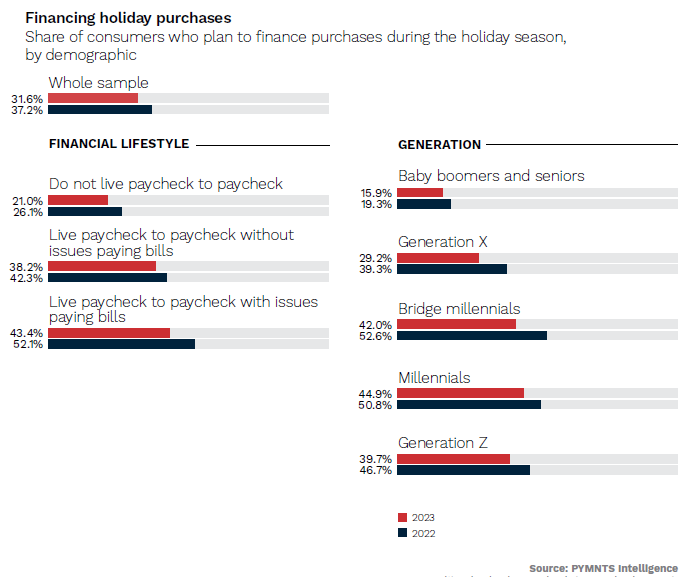1 in 5 of Consumers Without Paycheck Pressures Still Plan to Finance Holiday Purchases

As the holidays near, balancing tight budgets with the festive spirit can become a challenge. Which is why traditionally, many consumers turn to credit to navigate holiday expenses, ensuring celebrations are not marred by financial constraints. However, recent trends show a decline in reliance on credit for holiday shopping, hinting at smarter spending habits despite financial constraints.
These are some of the findings detailed in the latest edition of “New Reality Check: The Paycheck-to-Paycheck Report,” a PYMNTS Intelligence and LendingClub collaboration. The “Holiday Shopping Deep Dive Edition” draws on insights from a survey of over 3,600 U.S. consumers to examine the financial lifestyles and spending choices of U.S. consumers going into the 2023 holiday shopping season.
The report reveals that 32% of shoppers expect to use one or more credit options for their holiday shopping, down from 37% in 2022. This decrease indicates a growing inclination towards more cautious spending habits. Among the credit options, credit card financing remains the most popular, with 27% of shoppers planning to use credit cards for their holiday purchases. Additionally, buy now, pay later (BNPL) options have gained traction, especially among younger consumers, with 20% planning to use this financing method.

Furthermore, the share of holiday spending expected to be financed has also witnessed a decline. As the study noted, credit product usage is projected to account for only 13% of holiday spending this year, compared to 15% last year. This decrease suggests that consumers are relying less on credit to fund their holiday purchases and are instead opting for other payment methods or adjusting their spending habits.
The decrease in credit usage and financing for holiday shopping is observed across all demographics. Consumers who are struggling to pay their bills are the most likely to plan on using credit to cover their holiday spending. However, even among this group, the expected credit usage has decreased from 50% in 2022 to 43% this year.
Among consumers not living paycheck to paycheck, credit usage has also dipped from the 26% recorded in 2022, however 21% still plan on using credit to finance purchases this year.
When it comes to different generations, bridge millennials have experienced the largest drop in credit usage and the share of purchases they expect to finance. The share of millennials aiming to use credit has also dropped from about 50% to 45% between 2022 and 2023, while that of Generation X has decreased from 39% to 29%. The share of boomers and seniors planning to use credit to finance purchases remains relatively small, but there is still a decrease from the 19% recorded last year to 16% this year.
The report highlights that consumers’ financial standing and concerns about the economy play a significant role in their decision to decrease credit usage. Many consumers perceive themselves as worse off now compared to 2022, and a considerable percentage express concerns about the economic outlook. These factors contribute to a more conservative stance on spending and a reduced reliance on credit options.
In conclusion, consumers are using less credit for holiday shopping, showing they’re getting smarter about money. It’s not just about numbers — it’s a sign that celebrations don’t have to break the bank. Instead, it suggests a refocus on what really counts during the holidays: being together, feeling grateful, and making meaningful memories with less debt and financial stress.

